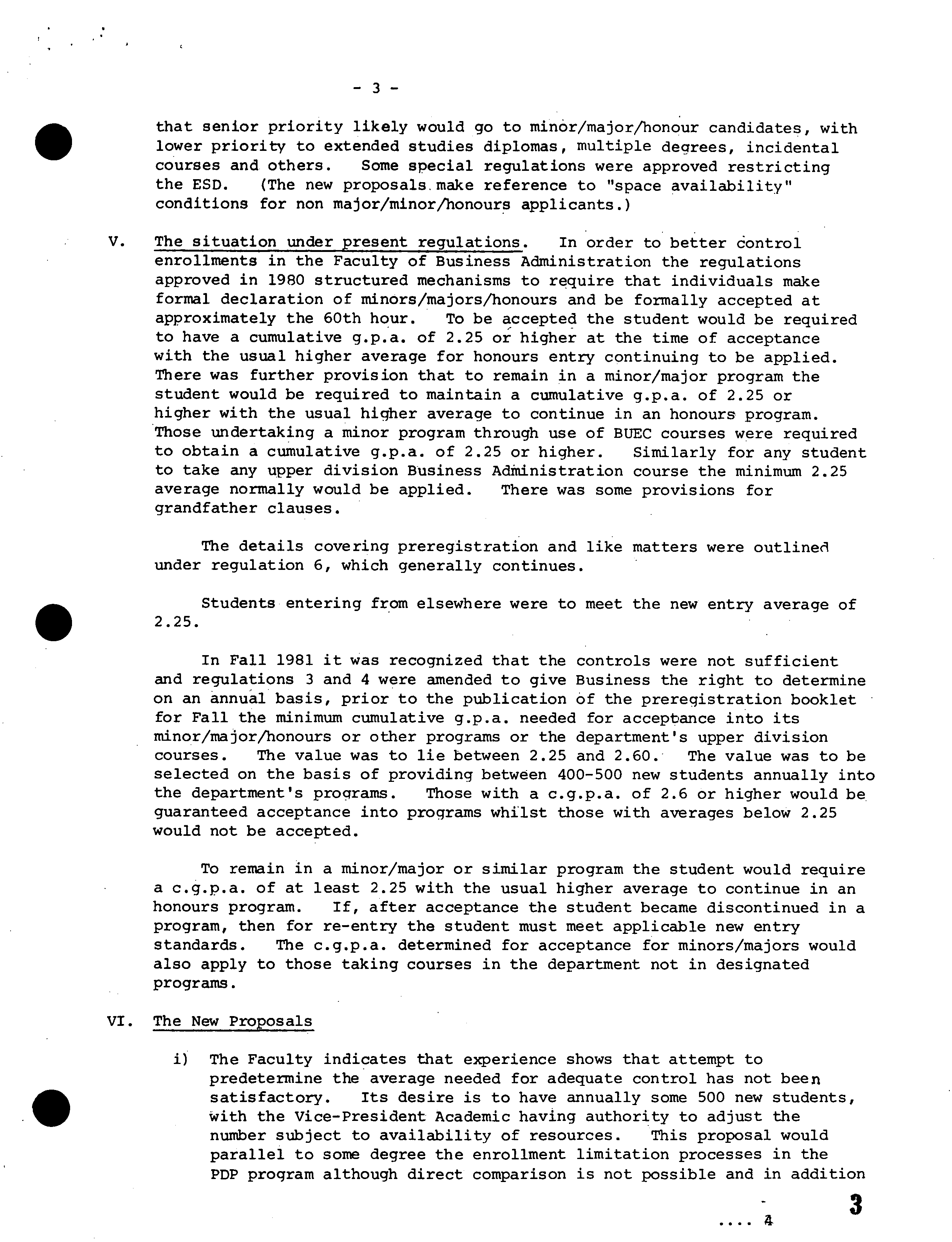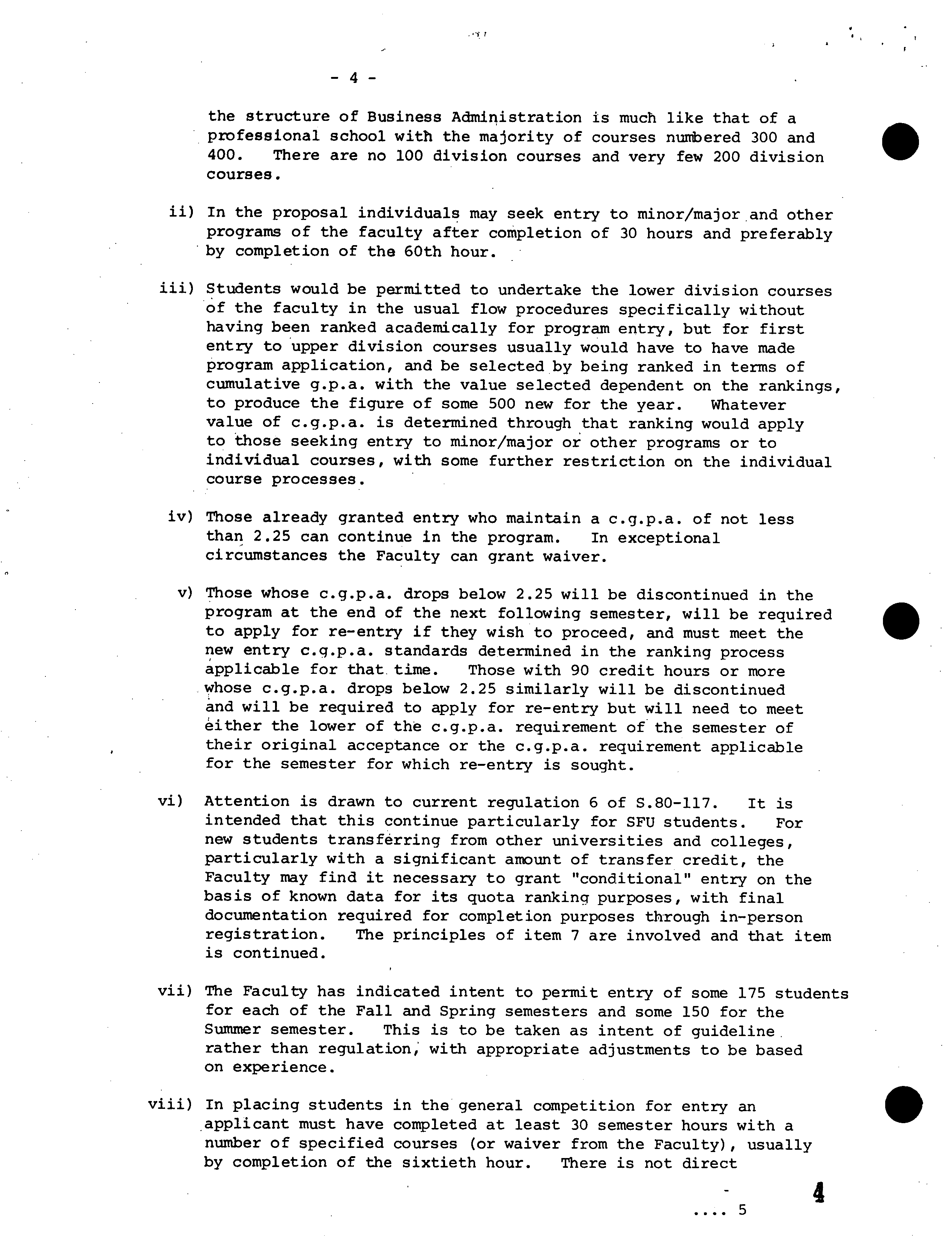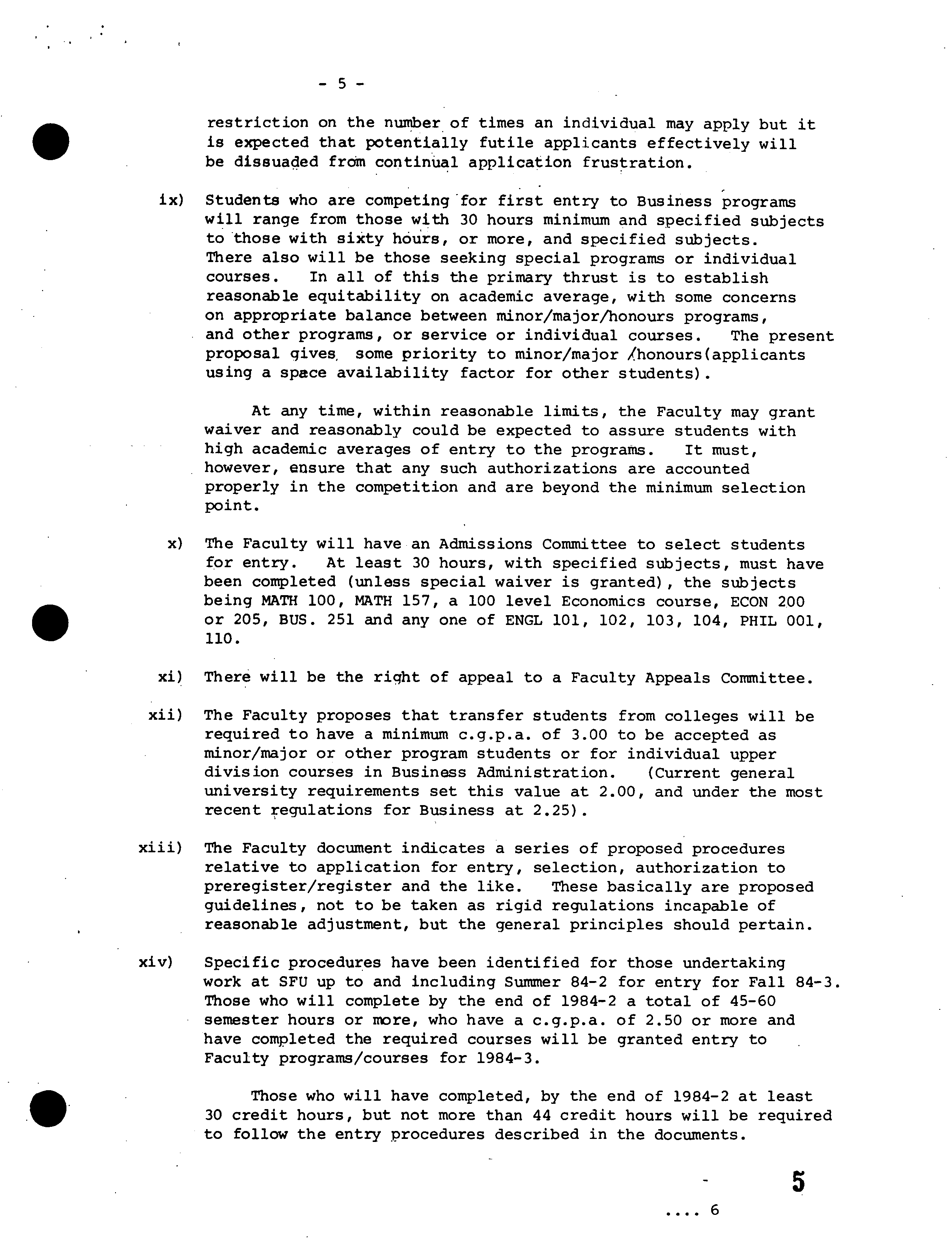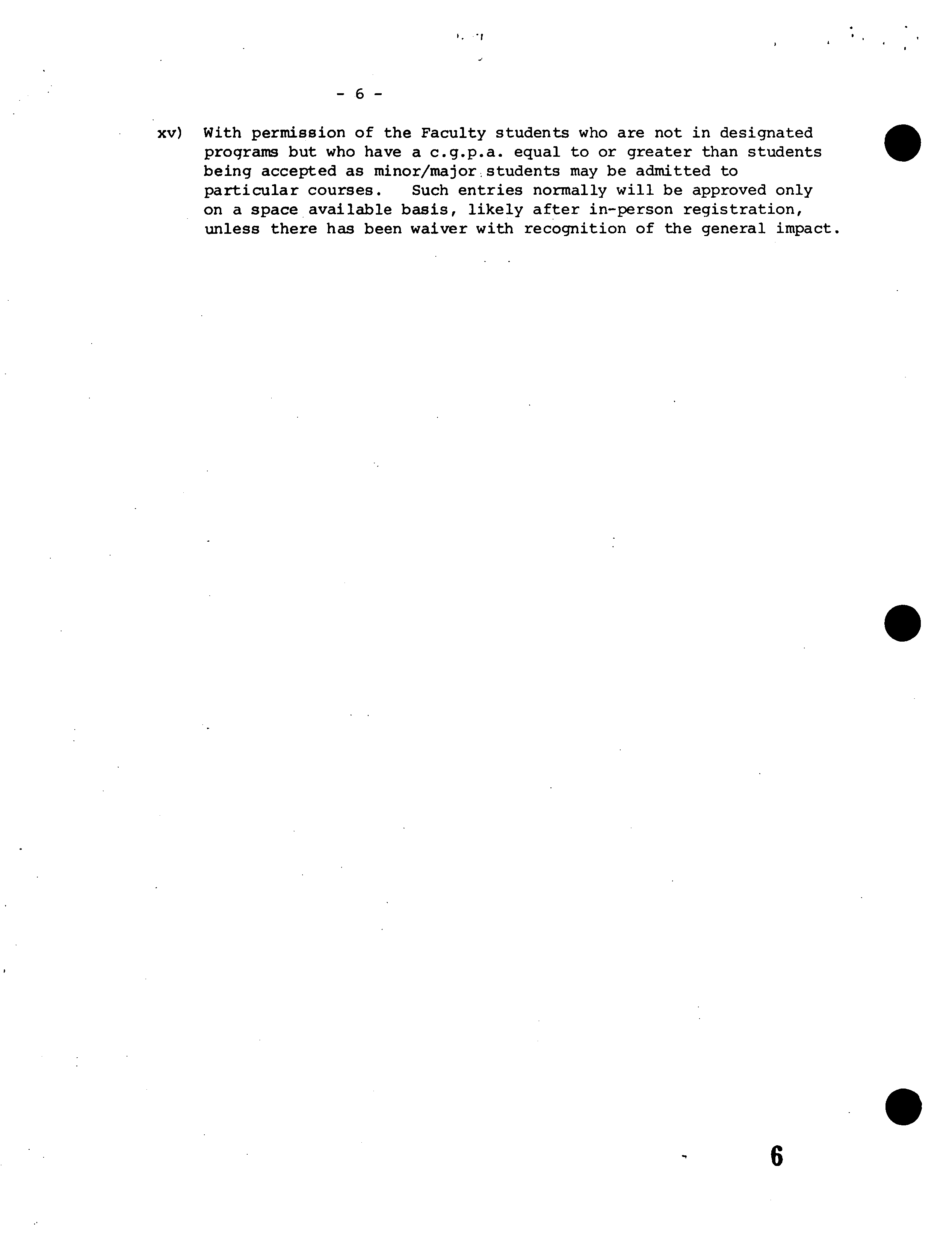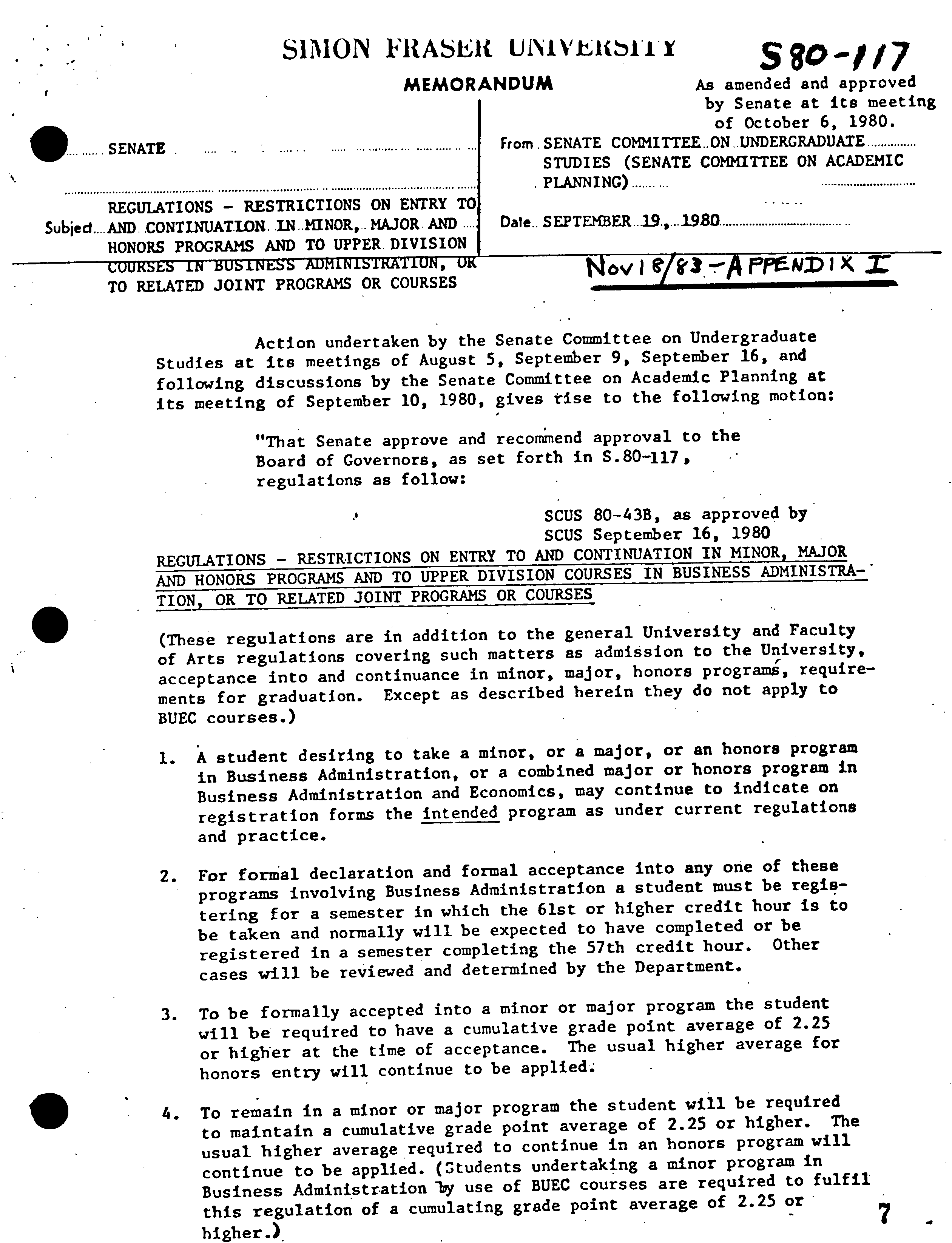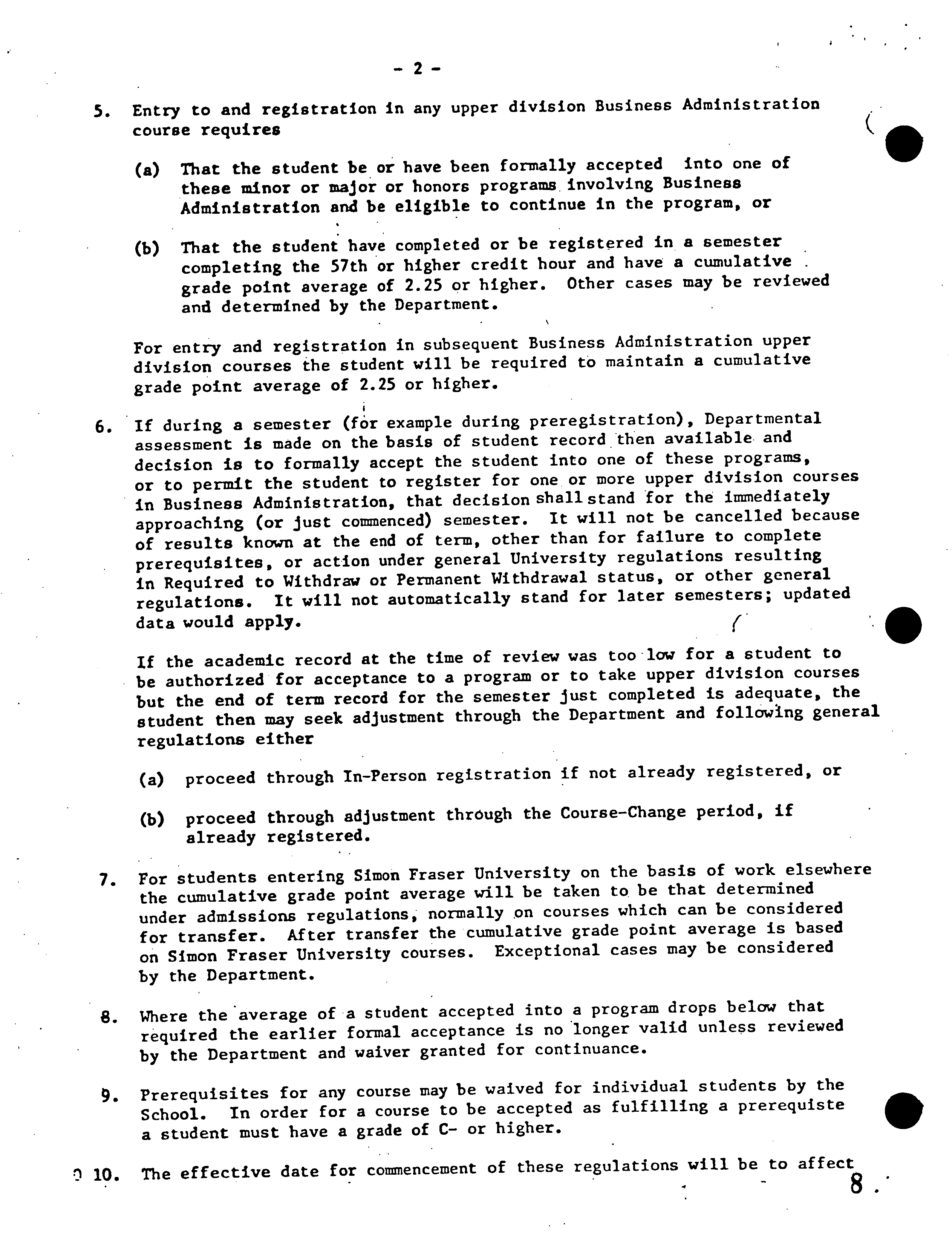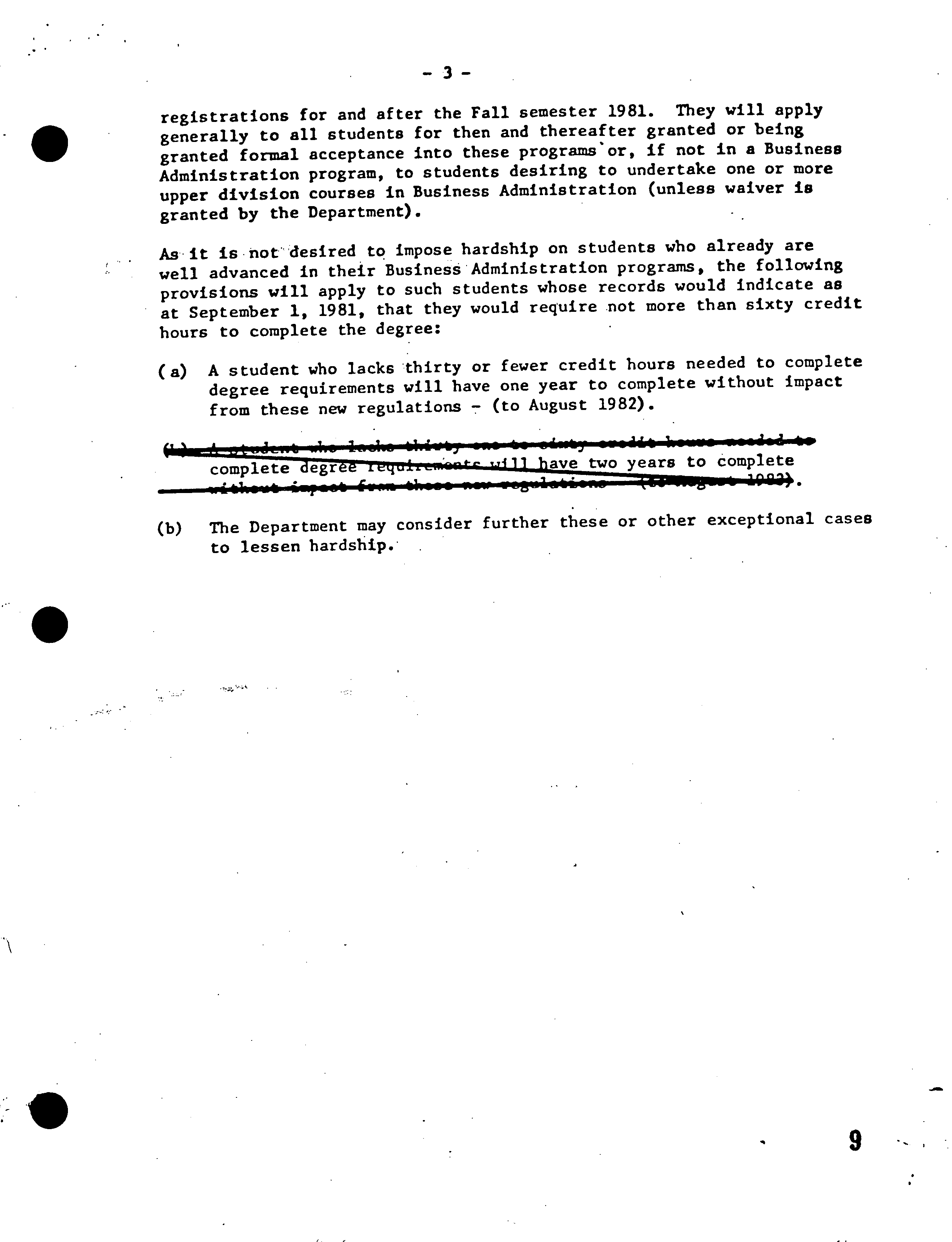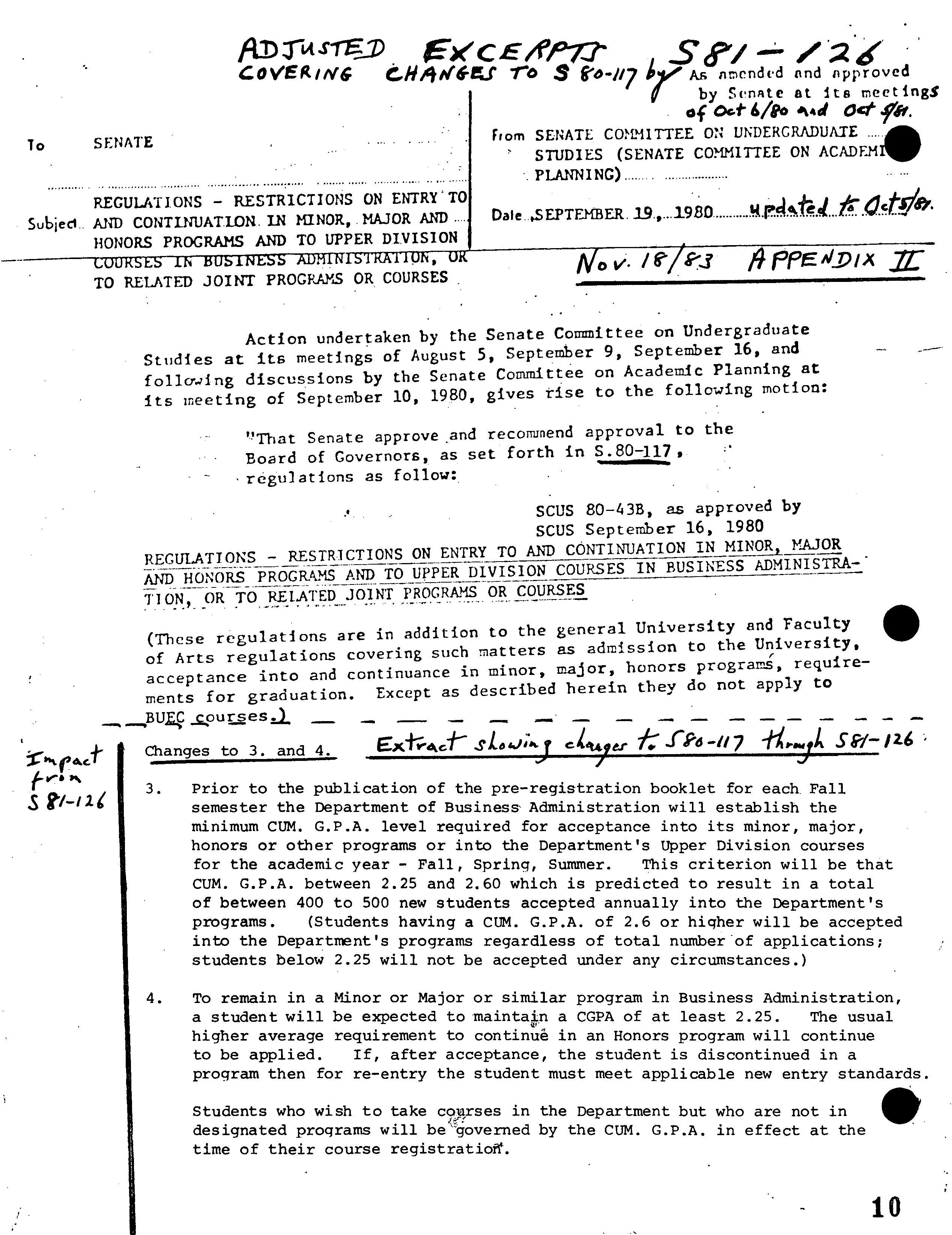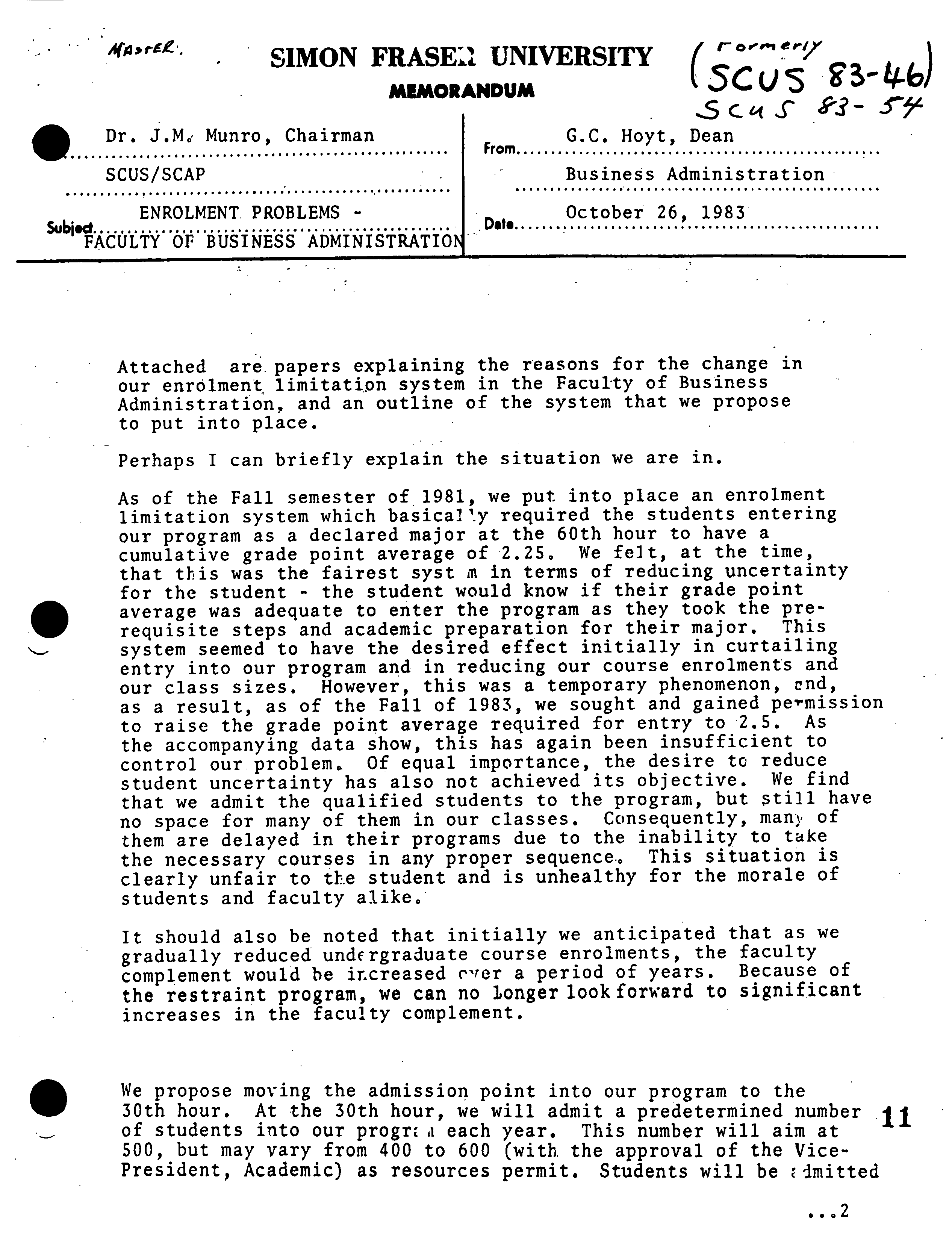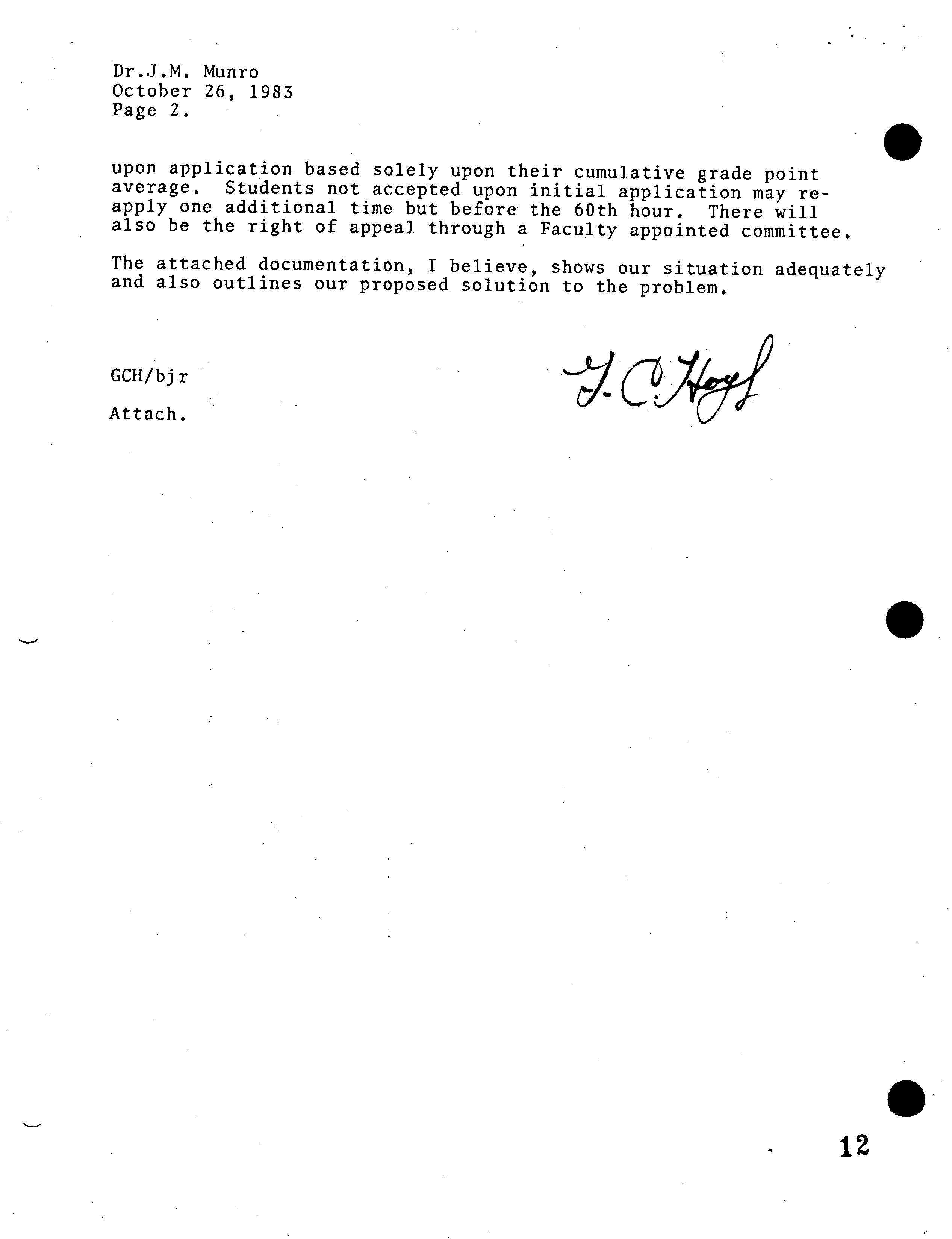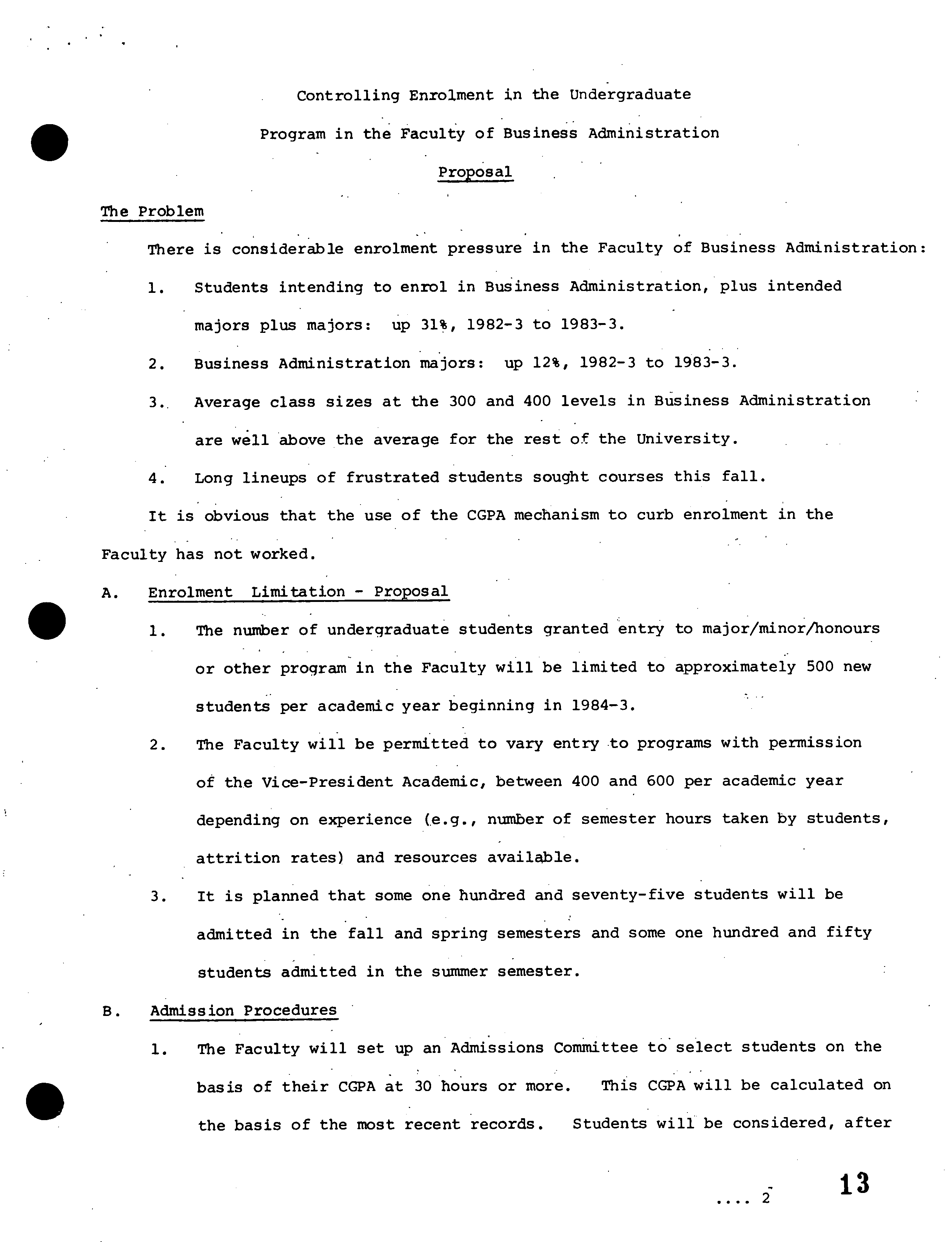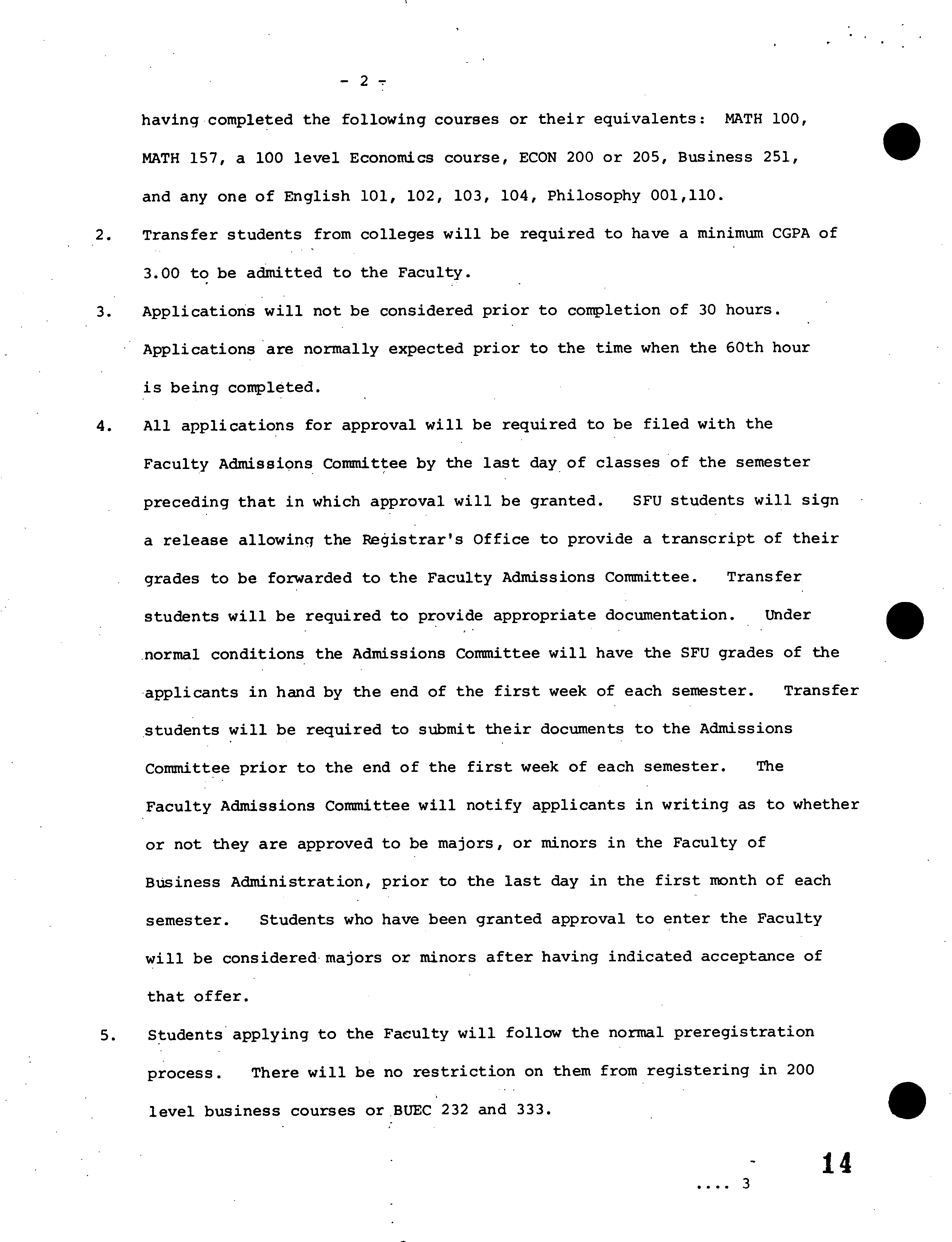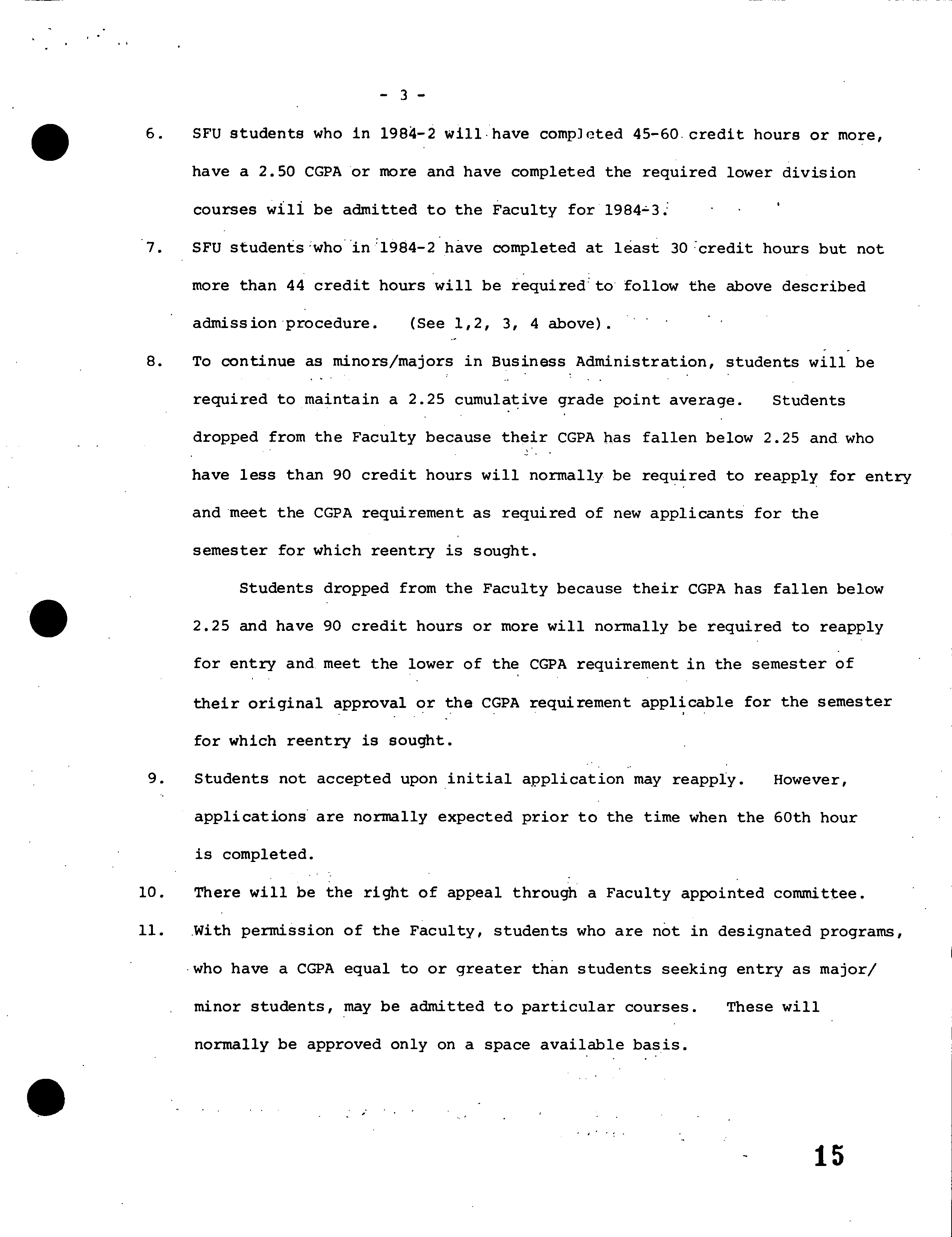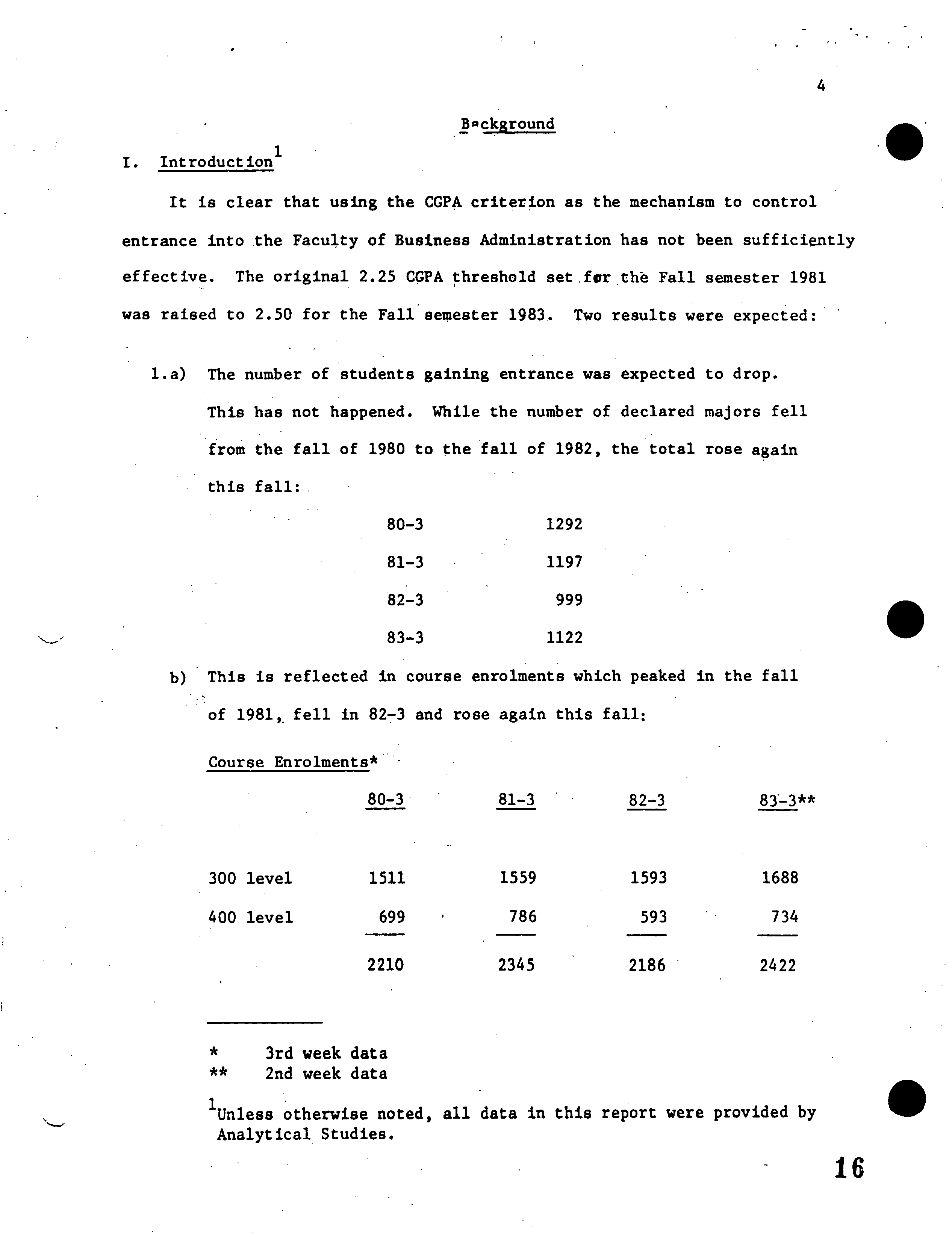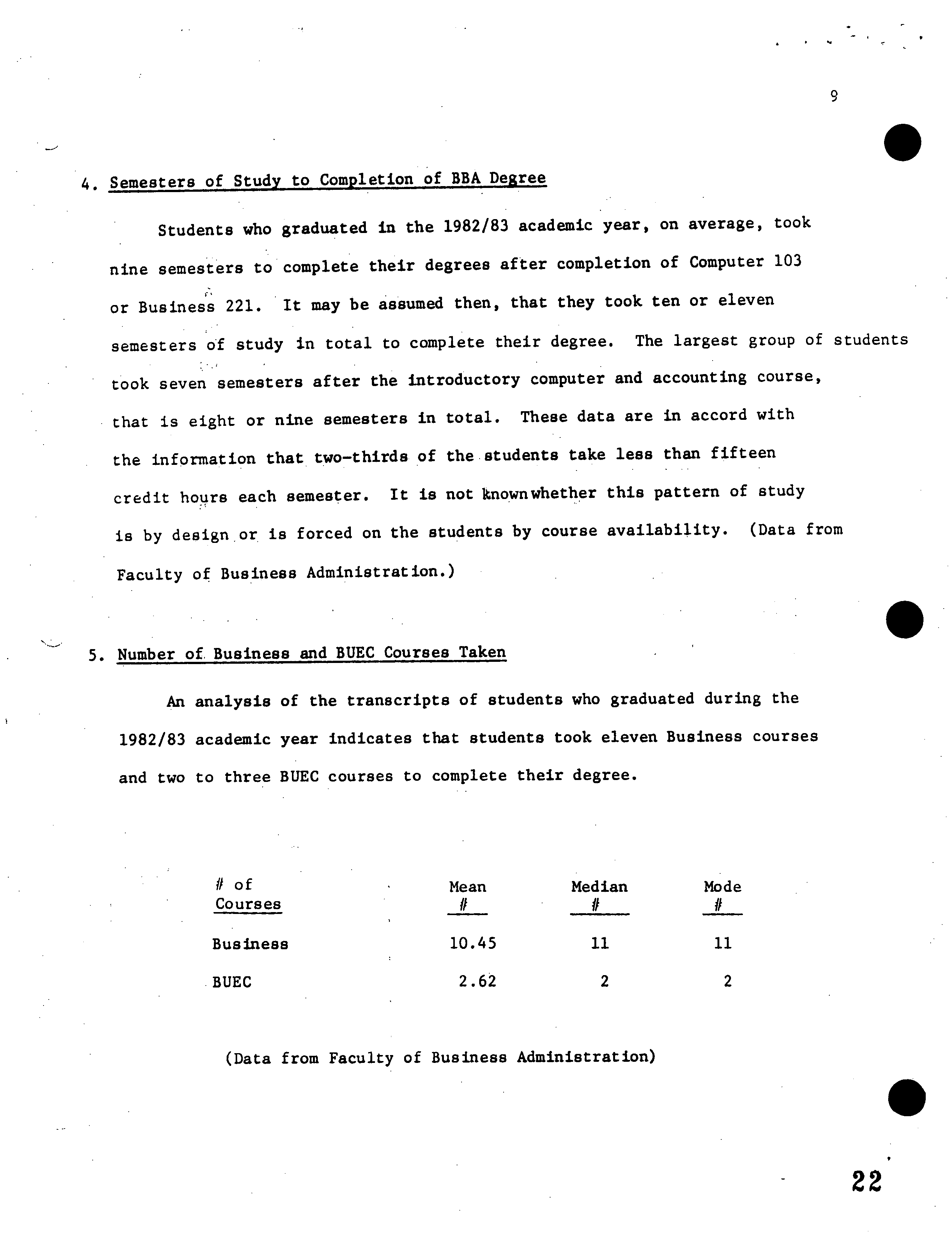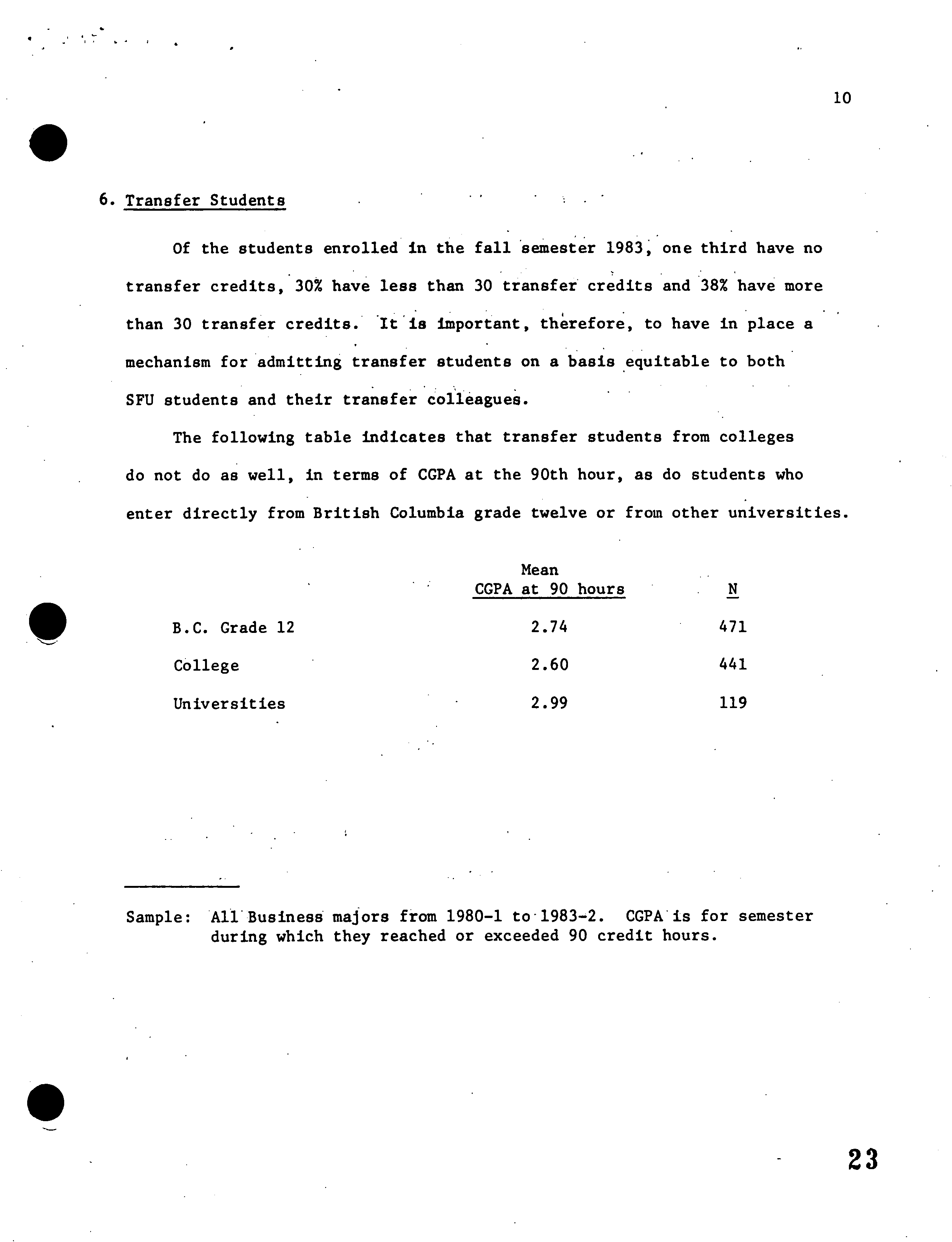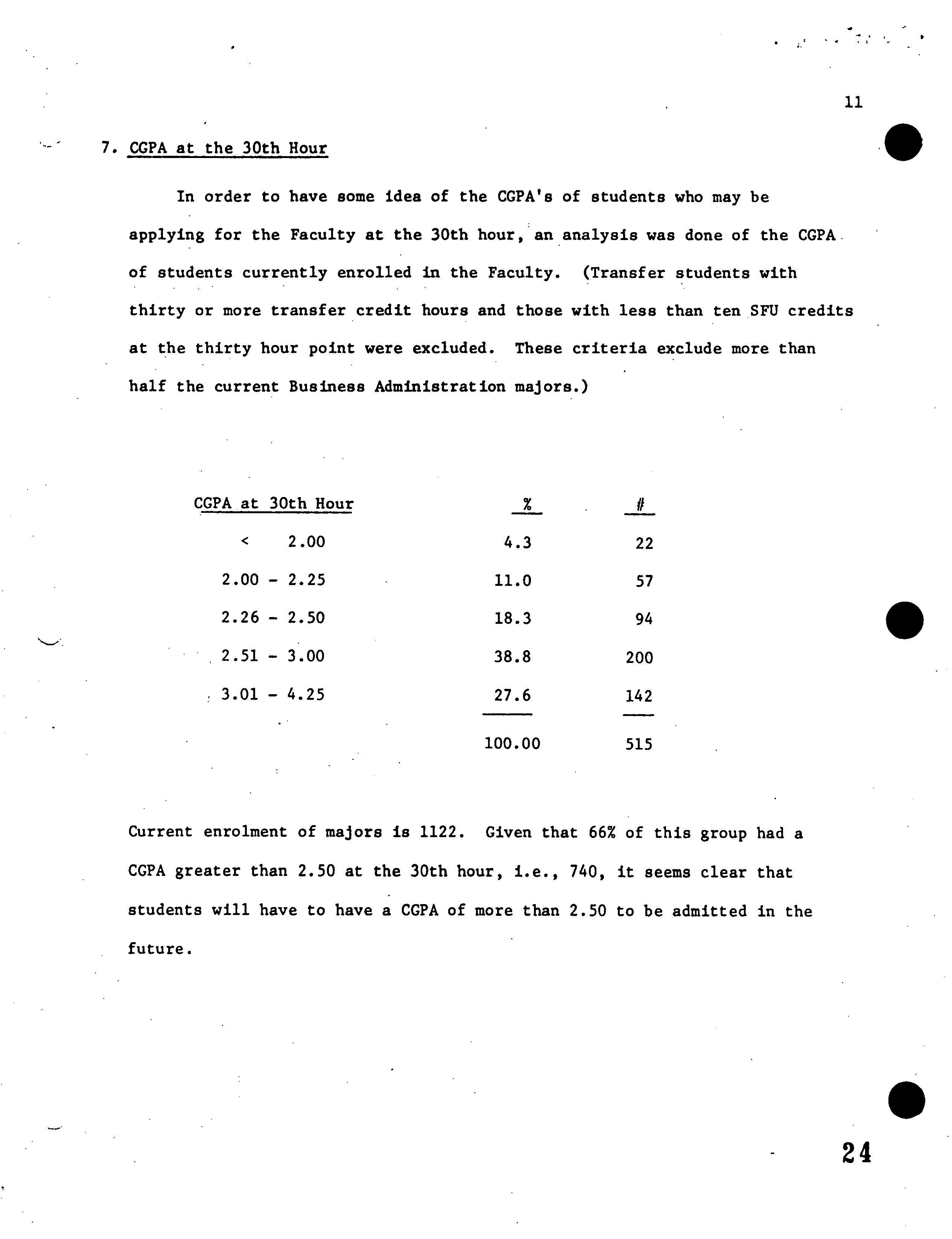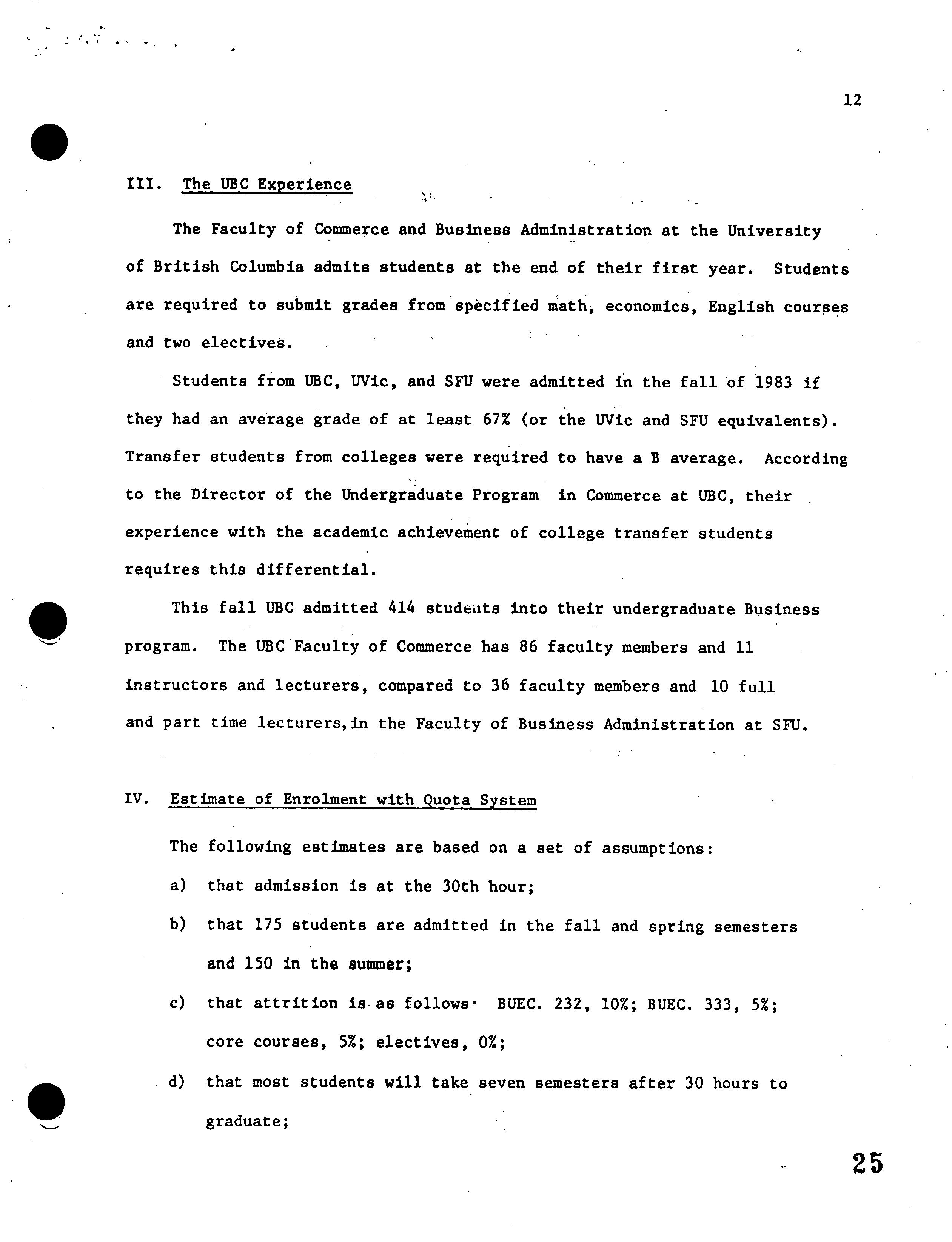SIMON HtAtIt UNIVItI1'X
?
S.3-/c'
MEMORANDUM
So
SENATE
?
?
From.. ?
9..
PLANNING
SENATE COMMITTEE ON UNDERGRADUATE STUDIES
Subjed
FACULTY OF BUSINESS ADMINISTRATION
.7.
PROPOSED CHANGE IN REGULATIONS -
Date.. NQY??. .i-?.. .
CONTINUATION IN MINOR, MAJOR AND
HONORS PROGRAMS AND '10 UPPER DIVISION
COURSES IN BUSINESS ADMINISTRATION,
OR TO RELATED JOINT PROGRAMS OR COURSES.
Action undertaken by the Senate Committee on Undergraduate Studies at
its meeting of November 1, November 8 and November 15, 1983 and following discussions
by the Senate Committee on Academic Planning at its meeting of November 9, 1983 gives
rise to the following motion:
MOTION:
"That Senate approve and recommend approval to the Board
of Governors, as set forth in S.83-101, the proposed
changes in regulations covering enrollment limitations
in the Faculty of Business Administration."
BACKGROUND INFORMATION
I.
Following intensive discussions between the School of Business
Administration and the university administration and after significant debate at
SCUS, SCAP and Senate - on October 6, 1980 Senate amended and approved
paper S.80-117 covering the initial regulations on enrollment limitations
in Business Administration. ?
Regulations on this type of topic require action
by the Board of Governors and the Board did approve the regulations.
Significant changes would still require Senate/Board action.
II.
The paper at that time made clear that the new regulations were in addition to
the general University and Faculty of Arts regulations covering such matters as
admission to the University, acceptance into and continuance in minor, major,
honors programs, requirements for graduation. Except as specifically described
in the documents they did not apply to BUEC courses; that general principle
still pertains, unless there is specific data otherwise.
Since that time Senate and the Board have approved a number of curricular
and other changes, through the normal on-going activities of Business
Administration, including establishment of Faculty status with separation from
the Faculty of Arts.
?
There have been certain program revisions, curricular
changes and like matters, but these have not changed the basic regulations
adopted in October, 1980 (effective for September 1981) on enrollment limitations,
with the exception of actions undertaken through SCUS/SCAP and then Senate on
October 5, 1981 (effective for September 1982) via paper S.81-126.
?
That paper
' ?
also was approved by the Board. Specifically the pertinent papers are S.80-117
and S.81-126. A brief indication of major points and changes follows
(,;=
understanding that the technical language of the papers and minutes of the bodies
prevail where the summary is abbreviated, incomplete, unclear, or possibly in .,
error).
....2
?
.1
-2 -
III. The 1980 proposal which was to affect entries for Fall 81-3 and later
(with some grandfather clauses) - Forsixnmary see S.80-l17 attached as
Appendix I hereto. These regulations were later changed in items 3 and 4
by S.81-126, and now are to be changed, if approved, by the actions now
proposed.
?
Unless specifically changed, or clearly changed by the thrust
of the new regulations, the regulation or general practice remains in effect.
Examples:- S.80-117 Appendix I
1. Continues
2.
Changes - The basic procedure for being first accepted into minor/
major/honors programs may commence after the 30th semester hour and
normally will be in place by completion of the 60th hour. Other cases
will be reviewed and determined by the Faculty.
3.) These items were changed by S.81-126, October 1981 (effective for entry
4.)
for Fall 82-3).
?
See explanation below, and Appendix II.
5.
5(a) continues. ?
5(b) changes'as the present value of 2.25 will be
the ranked average value determined each semester on the new quota base.
6. Continues
7. Continues - (subject to decision on entry averages from colleges).
8.
Continues (2.25 or higher normally required).
9. Continues.
10. changes, relative to date, with new regulations to apply to new
students for entry acceptance in Fall, 1984.
a)
has expired
b)
continues.
IV. The 1981 proposal which was to affect entries for Fall 82-3 and thereafter -
For summary see S.81-126 excerpts attached as Appendix II hereto. The
pertinent paper had significant impact, but was not to chang&a number of
prime-thrusts of S.80-117, but was to augment them.
The effect of these regulations was to recognize that the controls on
limiting enrollment, desired under S.80-117, were not being achieved, but to
attempt solution through a middle-of-the-road position, utilizing a sliding
(upward) minimum CGPA for entry to achieve the desired balance.
The Faculty notes some temporary gains in the early stages, but it
?
perceives as significant the failure in attempting to respond adequately and
?
fairly to its responsibilities to students admitted to its programs/courses.
That paper, S.81-126 in item 4, set conditions generally stringent on
those seeking other than minor/major/honor programs in Business Administration
but relative to those directly in Business the stringency undoubtedly is
appropriate as the same cgpa entry values are being applied for major/minor
and other applicants. ?
Reasonable efforts are needed to ensure that all
groups are apprised clearly of expectations and requirements.
?
It is noted
2
-3-
•
?
that senior priority likely would go to minor/major/honour candidates, with
lower priority to extended studies diplomas, multiple de
g
rees, incidental
courses and others.
?
Some special regulations were approved restricting
the ESD. ?
(The new proposals make reference to "space availability"
conditions for non major/minor/honours applicants.)
V.
The situation under present regulations.
?
In order to better control
enrollments in the Faculty of Business Administration the regulations
approved in 1980 structured mechanisms to require that individuals make
formal declaration of minors/majors/honours and be formally accepted at
approximately the 60th hour. To be accepted the student would be required
to have a cumulative g.p.a. of 2.25 or higher at the time of acceptance
with the usual higher average for honours entry continuing to be applied.
There was further provision that to remain in a minor/major program the
student would be required to maintain a cumulative g.p.a. of 2.25 or
higher with the usual higher average to continue in an honours program.
Those undertaking a minor program through use of BUEC courses were required
to obtain a cumulative g.p.a. of 2.25 or higher.
?
Similarly for any student
to take any upper division Business Administration course the minimum 2.25
average normally would be applied. There was some provisions for
grandfather clauses.
The details covering preregistration and like matters were outlined
under regulation 6, which generally continues.
Students entering from elsewhere were to meet the new entry average of
2.25.
In Fall 1981 it was recognized that the controls were not sufficient
and regulations 3 and 4 were amended to give Business the right to determine
on an annual basis, prior to the publication of the preregistration booklet
for Fall the minimum cumulative g.p.a. needed for acceptance into its
minor/major/honours or other programs or the department's upper division
courses. ?
The value was to lie between 2.25 and 2.60. The value was to be
selected on the basis of providing between 400-500 new students annually into
the department's programs.
?
Those with a c.g.p.a. of 2.6 or higher would be
?
guaranteed acceptance into programs whilst those with averages below 2.25
would not be accepted.
To remain in a minor/major or similar program the student would require
a c.g.p.a. of at least 2.25 with the usual higher average to continue in an
honours program. If, after acceptance the student became discontinued in a
program, then for re-entry the student must meet applicable new entry
standards.
?
The c.g.p.a. determined for acceptance for minors/majors would
?
also apply to those taking courses in the department not in designated
programs.
VI. The New Proposals
i) The Faculty indicates that experience shows that attempt to
predetermine the average needed for adequate control has not been
.
?
?
satisfactory. Its desire is to have annually some 500 new students,
?
with the Vice-President Academic having authority to adjust the
number subject to availability of resources. This proposal would
parallel to some degree the enrollment limitation processes in the
PDP program although direct comparison is not possible and in addition
-4-
the structure of Business Administration is much like that of a
professional school with the majority of courses nuithered 300 and
400. There are no 100 division courses and very few 200 division
?
is
courses.
ii)
In the proposal individuals may seek entry to minor/major and other
programs of the faculty after completion of 30 hours and preferably
by completion of the 60th hour.
iii)
Students would be permitted to undertake the lower division courses
of the faculty in the usual flow procedures specifically without
having been ranked academically for program entry, but for first
entry to upper division courses usually would have to have made
program application, and be selected by being ranked in terms of
cumulative g.p.a. with the value selected dependent on the rankings,
to produce the figure of some 500 new for the year. Whatever
value of c.g.p.a. is determined through that ranking would apply
to those seeking entry to minor/major or other programs or to
individual courses, with some further restriction on the individual
course processes.
iv)
Those already granted entry who maintain a c.g.p.a. of not less
than 2.25 can continue in the program.
?
In exceptional
circumstances the Faculty can grant waiver.
v)
Those whose c.g.p.a. drops below 2.25 will be discontinued in the
program at the end of the next following semester, will be required
to apply for re-entry if they wish to proceed, and must meet the
?
is
new entry c.g.p.a. standards determined in the ranking process
applicable for that. time. Those with 90 credit hours or more
whose c.g.p.a. drops below 2.25 similarly will be discontinued
and will be required to apply for re-entry but will need to meet
either the lower of the c.g.p.a. requirement of the semester of
their original acceptance or the c.g.p.a. requirement applicable
for the semester for which re-entry is sought.
vi)
Attention is drawn to current regulation 6 of S.80-117.
?
It is
intended that this continue particularly for SFU students.
?
For
new students transferring from other universities and colleges,
particularly with a significant amount of transfer credit, the
Faculty may find it necessary to grant "conditional" entry on the
basis of known data for its quota ranking purposes, with final
documentation required for completion purposes through in-person
registration. The principles of item 7 are involved and that item
is continued.
vii)
The Faculty has indicated intent to permit entry of some 175 students
for each of the Fall and Spring semesters and some 150 for the
Summer semester. This is to be taken as intent of guideline.
rather than regulation, with appropriate adjustments to be based
on experience.
viii)
In placing students in the general competition for entry an
applicant must have completed at least 30 semester hours with a
number of specified courses (or waiver from the Faculty), usually
by completion of the sixtieth hour. There is not direct
- ?
4
-5-
•
?
restriction on the number of times an individual may apply but it
is expected that potentially futile applicants effectively will
be dissuaded fran continual application frustration.
ix)
Students who are competing for first entry to Business programs
will range from those with 30 hours minimum and specified subjects
to those with sixty hours, or more, and specified subjects.
There also will be those seeking special programs or individual
courses. ?
In all of this the primary thrust is to establish
reasonable equitability on academic average, with some concerns
on appropriate balance between minor/major/honours programs,
and other programs, or service or individual courses. The present
proposal gives ,
some priority to minor/major /honours(applicants
using a space availability factor for other students).
At any time, within reasonable limits, the Faculty may grant
waiver and reasonably could be expected to assure students with
high academic averages of entry to the programs.
?
It must,
however, ensure that any such authorizations are accounted
properly in the competition and are beyond the minimum selection
point.
x)
The Faculty will have an Admissions Committee to select students
for entry. At least 30 hours, with specified subjects, must have
been completed (unless special waiver is granted), the subjects
being MATH 100, MATH 157, a 100 level Economics course, ECON 200
or 205, BUS. 251 and any one of ENGL 101, 102, 103, 104, PHIL 001,
110.
xi)
There will be the right of appeal to a Faculty Appeals Committee.
xii)
The Faculty proposes that transfer students from colleges will be
required to have a minimum c.g.p.a. of 3.00 to be accepted as
minor/major or other program students or for individual upper
division courses in Business Administration. ?
(Current general
university requirements set this value at 2.00, and under the most
recent regulations for Business at 2.25).
xiii)
The Faculty document indicates a series of proposed procedures
relative to application for entry, selection, authorization to
preregister/register and the like. These basically are proposed
guidelines, not to be taken as rigid regulations incapable of
reasonable adjustment, but the general principles should pertain.
xiv)
Specific procedures have been identified for those undertaking
work at SFU up to and including Summer 84-2 for entry for Fall 84-3.
Those who will complete by the end of 1984-2 a total of 45-60
semester hours or more, who have a c.g.p.a. of 2.50 or more and
have completed the required courses will be granted entry to
Faculty programs/courses for 1984-3.
S
Those who will have completed, by the end of 1984-2 at least
30 credit hours, but not more than 44 credit hours will be required
to follow the entry procedures described in the documents.
- ?
5
....6
-6-
xv) With permission of the Faculty students who are not in designated
programs but who have a c.g.p.a. equal to or greater than students
being accepted as minor/major students may be admitted to
particular courses. ?
Such entries normally will be approved only
on a space available basis, likely after in-person registration,
unless there has been waiver with recognition of the general impact.
S
S
6
•
?
SiMON FRASER U1\IVL!tb11
?
5 gO-,/7
MEMORANDUM ?
As amended and approved
by Senate at its meeting
of October 6, 1980.
0 ... ..... .
SENATE ...................................................From. SENATE COMMITTEE..ON..UNDERGRADIJATE...............
STUDIES (SENATE COMMITTEE ON ACADEMIC
.
PLANNING)
REGULATIONS - RESTRICTIONS ON ENTRY TO
Subjed....AND. CONTINUATION.- IN
?
MAJOR. AND ....
?
Dale.. SEPTEMBER...19.,....1980. ..................................... ..
HONORS PROGRAMS AND TO UPPER. DIVISION
?
WuXbLD LL
DUI.1E
?
Os'
1 ?
FPND1
TO RELATED JOINT PROGRAMS OR COURSES
Action undertaken by the Senate Committee on Undergraduate
Studies
at its
meetings of August 5, September 9, September 16, and
following discussions by the Senate Committee on Academic Planning at
its meeting of September 10, 1980, gives tise to the following motion:
"That Senate approve and recomnend approval to the
Board of Governors, as set forth in S.80-117,
regulations as follow:
1 ?
SCUS 80-43B, as approved by
SCUS September 16, 1980
REGULATIONS - RESTRICTIONS ON ENTRY TO AND CONTINUATION IN MINOR, MAJOR
AND HONORS PROGRAMS AND TO UPPER DIVISION COURSES IN BUSINESS
ADMINISTRA-
S ?
TION, OR TO RELATED JOINT PROGRAMS OR COURSES
(These regulations are in addition to the general University and Faculty
of Arts regulations covering such matters as admission to the University,
acceptance into and continuance in minor, major, honors programs, require-
ments for graduation. Except as described herein they do not apply to
BUEC courses.)
1.
A student desiring to take a minor, or a major, or an honors program
in
Business Administration, or a combined major or honors program in
Business Administration and Economics, may continue to indicate on
registration forms the intended program as under current regulations
and practice.
2.
For formal declaration and formal acceptance into any one of
these
programs involving Business Administration a student must be regis-
tering for a semester in which the 61st or higher credit hour is to
be taken and normally will be expected to have completed or be
registered in a semester completing the 57th credit hour. Other
cases will be reviewed and determined by the Department.
3.
To be formally accepted into a minor or major program the student
will be required to have a cumulative grade point average of 2.25
or higher at the time of acceptance. The usual higher average for
honors entry will continue to be applied.
4.
To remain in a minor or major program the student will be required
to maintain a cumulative grade point average of 2.25 or higher. The
usual higher average required to continue in an honors program will
continue to be applied. (Students undertaking a minor program
in
Business Administration
-
by use of BUEC courses are required to fulfil
this regulation of a cumulating grade point average of 2.25 or
?
higher.)
.
?
.
? . ?
- ?
7
-2-
5. Entry to and registration
in
any upper division Business Administration
course requires ?
(.
(a)
That the student be or have been formally accepted into one of
these minor or major or honors programs. involving Business
Administration and be eligible to continue in the program, or
(b)
That the student have completed or be registered in a semester
completing the 57th or higher credit hour and have a cumulative
grade point average of 2.25 or higher. Other cases may be reviewed
and determined by the Department.
For entry and registration in subsequent Business Administration upper
division courses the student will be required to maintain a cumulative
grade point average of 2.25 or higher.
6. If during a semester (for example during preregistration), Departmental
assessment is made on the basis of student record
,
then available and
decision is to formally accept the student into one of these programs,
or to permit the student to register for one or more upper division courses
in Business Administration, that decision shall stand 'for the immediately
approaching (or just commenced) semester. It will not be cancelled because
of results known at the end of term, other than for failure to complete
prerequisites, or action under general University regulations resulting
in Required to Withdraw or Permanent Withdrawal status, or other general
regulations. It will not automatically stand for later semesters; updated
data would apply.
If the academic record at the time of review was too 'low for a student to
be authorized for acceptance to a program or to take upper division courses
but the end of term record for the semester just completed is adequate, the
student then may seek adjustment through the Department and following general
regulations either
(a)
proceed through In-Person registration if not already registered, or
(b)
proceed through adjustment through the Course-Change period, if
already registered.
7. For students entering Simon Fraser University on the basis of work elsewhere
the cumulative grade point average will be taken to be that determined
under admissions regulations, normally on courses which can be considered
for transfer. After
transfer the cumulative grade point average is based
on Simon Fraser University courses. Exceptional cases may be considered
by the Department.
S. Where the average of a student accepted into a program drops below that
required the earlier formal acceptance is no longer valid unless reviewed
by the Department and waiver granted for continuance.
9.
Prerequisites for any course may be waived for individual students by the
School. In order for a course to be accepted as fulfilling a prerequiste
a student must have a grade of C- or higher.
O 10. The effective date for commencement of these regulations will be to affect
- ?
8
-3-
registrations for and after the Fall semester 1981. They will apply
. ?
generally to all students for then and thereafter granted or being
granted formal acceptance into these programsor, if
not in a Business
Administration
program, to students desiring to undertake one or more
upper division
courses in Business Administration (unless waiver is
granted by the Department).
As' it isnot"desired to impose hardship on students who already are
well advanced in their Business Administration programs, the following
provisions will apply to such students whose records would indicate as
at September 1, 1981, that they would require not more than sixty credit
hours to complete the degree:
(a)
A student who lacks 'thirty or fewer credit hours needed to complete
degree requirements will have one year to complete without impact
from these new regulations
?
(to August 1982).
complete deg
?
two years to complete
(b)
The Department may consider further these or other exceptional cases
to lessen hardship.'
10
9,
61
x'ce,fP72
?
S/-/I
OVERiiY&
,4N
#
6!
1O
S
o-117
£4y"
M amended and approved
(1
?
by SenRte at its nectingS
of
Oct
6/go
ad Oct
fey.
To ?
SENATE
??
.
............
From
SENATE
COMMITTEE
ON UNDERGRADUATE .....
?
STUDIES (SENATE COMMITTEE ON ACADEM
..PLANNING) ...........................
?
REGULATIONS - RESTRICTIONS ON ENTRY'TO
?
. ?
.
Subjed AND CONTLNUAT.LON. IN MINOR, MAJOR AND
?
....
?
Dale. SEPTEMBER. 19.,...1980............
HONORS
PROGRAMS
AND TO UPPER DIVISION
?
- UUURSLS 1t
1USiNLSS
AD1ffSflATIP?c01
?
iVr..v
?
/6/4c-
7
JE
TO RELATED
JOINT PROGRAMS
OR COURSES
Action undertaken by the Senate Committee on Undergraduate
Studies at its meetings of August 5, September 9, September 16, and
?
-
?
following discussions by the Senate Committee on Academic Planning at
Its meeting of September 10, 1980, gives rise to the following motion
'That
Senate approve and recommend approval to the
Board of Governors, as set forth in S.80-117,
?
?
regulations as follow
:
.
?
. ?
-.
fr.,
1 ?
SCUS 80-43B, as approved by
scus
September 16, 1980
REGULATIONS- RESTRICTIONS
TRY
TO AND
CONTI
N1.JATI ON
?
MINOR$
-
Y-AJOR
N HONORS
?
A
ND
TO UPPER DIVISION
COURSES
IN
BUSINESS
ADMINIsTRA
COURSES
TION,
OR TO
REt
ED JO NT
OCRAMS
(These regulations are in addition to the general University and Faculty
of Arts regulations covering such matters as admission to the University,
acceptance into and continuance in minor, major, honors programs, require-
ments for graduation. Except as described herein they do not apply to
BUQ puesj -
Changes to 3. and 4.
3.
Prior to the publication of the pre-registration booklet for each. Fall
semester the Department of Business' Administration will establish the
minimum CUM. C.P.A. level required for acceptance into its minor, major,
honors or other programs or into the Department's Upper Division courses
for the academic year - Fall, Spring, Summer. ?
This criterion will be that
CUM. G.P.A. between 2.25 and 2.60 which is predicted to result in a total
of between 400 to 500 new students accepted annually into the Department's
programs.
?
(Students having a
CUM.
C.P.A. of 2.6 or higher will be accepted
into the Department's programs regardless of total number of applications;
students below 2.25 will not be accepted under any circumstances.)
4.
To remain in a Minor or Major or similar program in Business Administration,
a student will be expected to maintain a CGPA of at least 2.25. ?
The usual
higher average requirement to continue in an Honors program will continue
to be applied.
?
If, after acceptance, the student is discontinued in a
program then for re-entry the student must meet applicable new entry standards.
Students who wish to take courses in the Department but who are not in
^, r ( ?
0
designated programs will be 'governed by the CUM. G.P.A. in effect at the
time of their course registratiof.
E'tc±
sL64j;
1 c
449J-
i;:
fso -"7
.
ti-.w t
S/ —
l2
10
• SiMON FRASE1 UNIVERSITY
MEMORANDUM
/
ro.-"ierlf
(5cu
gL,b
S'iS
cc'3—$'
Dr.
J.M0•
Munro, Chairman
SCUS/SCAP
ENROLMENT. PROBLEMS -
Sub
lid
...............................................
FACULTY OF BUSINESS ADMINISTRATIO
oyt
G.C. H, Dean
From
........................................................
Business Administration
October 26, 1983
Dat.
...............................................
Attached are.papers explaining the reasons for the change in
our enrolment
,
limitation system in the Faculty of Business
Administration, and an outline of the system that we propose
to put into place.
Perhaps I can briefly explain the situation we are in.
As of the Fall semester of 1981, we put into place an enrolment
limitation system which basicaly required the students entering
our program as a declared major at the 60th hour to have a
cumulative grade point average of 2.25. We felt, at the time,
that this was the fairest syst
at
in terms of reducing uncertainty
for the student - the student would know if their grade point
. ?
average was adequate to enter the program as they took the pre-
requisite steps and academic preparation for their major. This
system seemed to have the desired effect initially in curtailing
entry into our program and in reducing our course enrolments and
our class sizes. However, this was a temporary phenomenon, end,
as a result, as of the Fall of 1983, we sought and gained pe'mission
to raise the grade point average required for entry to 2.5. As
the accompanying data show, this has again been insufficient to
control our problem.. Of equal importance, the desire to reduce
student uncertainty has also not achieved its objective. We find
that we admit the qualified students to the program, but still have
no space for many of them in our classes. Consequently, many of
them are delayed in their programs due to the inability to take
the necessary courses in any proper sequence.. This situation is
clearly unfair to the student and is unhealthy for the morale of
students and faculty alike.
It should also be noted that initially we anticipated that as we
gradually reduced undergraduate course enrolments, the faculty
complement would he increased c"rer a period of years. Because of
the restraint program, we can no longer look forward to significant
increases in the faculty complement.
S ?
We propose moving the admission point into our program to the
30th hour. At the 30th hour, we will admit a predetermined number
of students into our progr
i
each year. This number will aim at
500, but may vary from 400 to 600 (with. the approval of the Vice-
President, Academic) as resources permit. Students will be 1mitted
Dr.J.M. Munro
October 26, 1983
Page
2.
r
L
upon application based solely upon their cumulative grade point
average. Students not accepted upon initial application may re-
apply one additional time but before the 60th hour. There will
also be the right of appeal. through a Faculty appointed committee.
The attached documentation, I believe, shows our situation adequately
and also outlines our proposed solution to the problem.
i
if
1pew
loal
GCH/bj r
Attach.
.
S
12
Controlling Enrolment in the Undergraduate
Program in the Faculty of Business Administration
Proposal
The Problem
There is considerable enrolment pressure in the Faculty of Business Administration:
1.
Students intending to enrol in Business Administration, plus intended
majors plus majors: up 31%, 1982-3 to 1983-3.
2.
Business Administration majors: up 12%, 1982-3 to 1983-3.
3.. Average class sizes at the 300 and 400 levels in Business Administration
are well above the average for the rest of the University.
4. Long lineups of frustrated students sought courses this fall.
It is obvious that the use of the CGPA mechanism to curb enrolment in the
Faculty has not worked.
A. Enrolment Limitation - Proposal
1.
The number of undergraduate students granted entry to major/minor/honours
or other program in the Faculty will be limited to approximately 500 new
students per academic year beginning in 1984-3.
2.
The Faculty will be permitted to vary entry to programs with permission
of the Vice-President Academic, between 400 and 600 per academic year
depending on experience (e.g., number of semester hours taken by students,
attrition rates) and resources available.
3.
It is planned that some one hundred and seventy-five students will be
admitted in the fall and spring semesters and some one hundred and fifty
students admitted in the summer semester.
B.
?
Admission Procedures
1. The Faculty will set up an Admissions Committee to select students on the
. ?
basis of their CGPA at 30 hours or more. This CGPA will be calculated on
the basis of the most recent records. Students will be considered, after
13
-2 -
having completed the following courses or their equivalents: MATH 100,
MATH 157, a 100 level Economics course, ECON 200 or 205, Business 251,
and any one of English 101, 102, 103, 104, Philosophy 001,110.
2.
Transfer students from colleges will be required to have a minimum CGPA of
3.00 to be admitted to the Faculty.
3.
Applications will not be considered prior to completion of 30 hours.
Applications are normally expected prior to the time when the 60th hour
is being completed.
4.
All applications for approval will be required to be filed with the
Faculty Admissions Committee by the last day of classes of the semester
preceding that in which approval will be granted. SFU students will sign
a release allowing the Registrar's Office to provide a transcript of their
grades to be forwarded to the Faculty Admissions Committee. Transfer
students will be required to provide appropriate documentation. Under
normal conditions the Admissions Committee will have the SFU grades of the
applicants in hand by the end of the first week of each semester. Transfer
students will be required to submit their documents to the Admissions
Committee prior to the end of the first week of each semester. The
Faculty Admissions Committee will notify applicants in writing as to whether
or not they are approved to be majors, or minors in the Faculty of
Business Administration, prior to the last day in the first month of each
semester. Students who have been granted approval to enter the Faculty
will be considered' majors or minors after having indicated acceptance of
that offer.
5.
Students' applying to the Faculty will follow the normal preregistration
process. There will be no restriction on them from registering in 200
level business courses or BUEC 232 and 333.
- ?
14
-3-
6.
SFTJ students who in 1984-2 will-have completed 45-60. credit hours or more,
have a 2.50 CGPA or more and have completed the required lower division
courses will be admitted to the Faculty for 1984_3.
7. SFU studentswho inl9842 have completed at least 30- credit hours but not
more than 44 credit hours will be required to follow the above described
admission procedure.
?
(See 1,2, 3, 4 above).
8.
To continue as minors/majors in Business Administration, students will be
required to maintain a 2.25 cumulative grade point average.
?
Students
dropped from the Faculty because their CGPA has fallen below 2.25 and who
have less than 90 credit hours will normally be required to reapply for entry
and meet the CGPA requirement as required of new applicants for the
semester for which reentry is sought.
Students dropped from the Faculty because their CGPA has fallen below
2.25 and have 90 credit hours or more will normally be required to reapply
for entry and meet the lower of the CGPA requirement in the semester of
their original approval or the CGPA requirement applicable for the semester
for which reentry is sought.
9. Students not accepted upon initial application may reapply. However,
applications are normally expected prior to the time when the 60th hour
is completed.
10.
There will be the right of appeal through a Faculty appointed committee.
11.
With permission of the Faculty, students who are not in designated programs,
who have a CGPA equal to or greater than students seeking entry as major/
minor students, may be admitted to particular courses. These will
normally be approved only on a space available basis.
.
?
.
15
4
Background
I. Intro duction1
It is clear that using the CGP4 criterion as the mechanism to control
entrance into the Faculty of Business Administration has not been sufficiently
effective. The original 2.25 CGPA threshold set for the Fall semester 1981
was raised to 2.50 for the Fall semester 1983.. Two results were expected:
l.a) The number of students gaining entrance was expected to drop.
This has not happened. While the number of declared majors fell
from the fall of 1980 to the fall of 1982, the total rose again
this fall:
?
80-3 ?
1292
?
81-3 ?
.
?
1197
?
82-3 ?
999
?
83-3 ?
1122
b) - This is reflected in course enrolments which peaked in the fall
of 1981, fell in 82-3 and rose again this fall:
Course Enrolments*
80-3 ?
81-3 ?
82-3 ?
83_3**
300 level ?
1511
1559
1593
1688
400 level ?
699
786
593
734
2210
2345
2186
2422
* ?
3rd week data
** ?
2nd week data
1 Unless
otherwise noted,
all data in
this report were
provided by
Analytical Studies.
16
/
di
c) Increased
?
enrolments have resu
large
class sizes.
In 82:3 section sizes in Business Administration
200
level were three times
?
as those in the,iPatynt;
at the 300 level they were Z times
ee-arge
nd at the 400
/
level sizes in Business were
?
times large than those in .*z•.
/
similar
Average section sizes 82:3
/
(9kL4.
Bi.'sineS
100 level
NA
66V
6'.
200 level
11 ?
.4
7.
level
69.9
2-3
S
300
400 level
/ 22.8
d) As well, long lines of fru/trated students have sought seats in
Business courses. Dunn the Drop/Add period in the fall of 1983,
1392 signatures were p ced by students seeking places in Business
Administration coursj.
Signatures
/
400
se
Places 83-3:
level ?
318
level ?
741
level ?
331
1392
(Data from Faculty of
Business Adminstration)
- ?
17
5
c)
Increased ?
enrolments have resulted in large
class sizes.
In 82:3 section sizes in Business Administration at the 200
level, were three times
I
w
LD'
1L
1lo:e
'
i
i
f t
Z
?
of
/je
at, the 300 level, they were
2
.
?
t1et
?
and at the 400
level sizes in Business were
/.
t7e.,
/4,7,&,,_1Los& !
rest
o f
te
Average sectionsizes 82:3
'L.,e%JiaJas?
?
Business ?
U..^ev.ruy
9u.nstetZ
100 level ?
NA
200 level ?
118.4 ?
37. S
300 level
?
69.9
400 level
?
22.8 ?
lt3
d)
As well, long lines of frustrated students have sought seats in
Business courses. During the Drop/Add period in the fall of 1983,
1392 signatures were placed by students seeking places in Business
Administration courses.
Signatures for Course Places 83-3:
200 level ?
318 ?
(Data from Faculty of
300 level
?
741 ?
Business Adminstration)
400 level
333
1392
S
-
?
18
.
6
This has caused a pedagogically unsound situation. We are allowing
students to declare a major in a program which does not have
sufficient resources to meet their needs.
?
Students are
unable to obtain places in courses they require and class
sizes In too many-instances-are too large.
2.
?
It was expected that increasing the CGPA threshold would reduce
the number of students attempting to gain entrance. This has
not happened. In the fall semester 1982, 1816 individuals were
declared majors, intended majors, or had indicated a desire to
enter the Faculty. This semester (83-3) that number has jumped
31% to 2379.
Because of various forces it is not expected that changes in the
method of enrolment control will result in a decrease in demand to
enter the Faculty.
II. Current Undergraduate Student Population
1. ?
The undergraduate pipeline. The flow of students through the Faculty's
undergraduate program is represented in the diagram below. At the Introduction
Stage, in an academic year, between 1500 - 1600 students are enrolled in
Business 251 (Accounting). It is not known what proportion of these students
intend to become Business majors and what proportion are taking the course for
interest only. At the Sorting Out stage between 750 and 925 students are
enrolled in BUEC. 232 and 333 (Statistics). Approximately 75% of these students
are intended Business Administration majors. At the Core stagebetween 500 and
19
Enrolments
1500
1200
900
600
300
S
700 students are enrolled in core co :ses. The Faculty graduates. approximately
375 individuals each year, about 350 of whom are majors:
The Undergraduate Pipeline
Introduction Sorting
?
Core
?
Graduands ?
Out
2. Full-time and part-time students. Of the 1122 students taking upper division
courses in the Faculty in 83-3, approximately 66% are enrolled in twelve
or more hours and hence could be described as full-time. The table below
indicates that more than half of the btudents enrolled in the summer semester
1983 could be classified as part-tim students.
?
is
?
- ?
20
8
1^1
Semester
Credits per
1982-3
1983-1
1983-2
1983-3
Semester
II
%
1/
%
%
%
•
?
7
183
18
186
18
262
30
201
18
8-11
133
13
179
17
200
25
182
16
12
680
68
676
65
406
46
738
66
996 100%
1041
100%
888
100%
1121
100%
W]
3. Full-time and part-time students by CGPA. If students are to be admitted
to the Faculty by CGPA,
and
no distinction is to be made between full-time and
part-time students, it is important
t
know whether this selection process
will affect the proportions of full Pnd part-time students. Based on
1983-1 data it does not appear that the proportion of full and part-time
students will be changed by selecting a quota of students using a CGPA -
criterion.
Cumulative Hours at end of 1983-1
Semester Hours
1983-1
< ?
12
'
?
12
60-90
Mean
CGPA ?
N
?
2.72 ?
(156)
?
2.72
?
(349)
91-120
Mean
CGPA
?
2.75 ?
(157)
?
2.74 ?
(231)
121+
Mean
CGPA ?
N
284 ?
(41)
2.81 ?
(17)
Total
Mean •
CGPA ?
N
2.75 (354)
2.73 (579)
is
21
9
4. Semesters of Study to Completion of BBA Degree
Students who graduated in the 1982/83 academic year, on average, took
nine semesters to complete their degrees after completion of Computer 103
or Business 221. It may be assumed then, that they took ten or eleven
semesters of study in total to complete their degree. The largest group of students
took seven semesters after the introductory computer and accounting course,
that is eight or nine semesters in total. These data are in accord with
the information that two—thirds of the students take less than fifteen
credit hours each semester. It 18 not Inownwhether this pattern of study
is by design or is forced on the students by course availability. (Data from
Faculty of Business Administration.)
S
5. Number of, Business and BUEC Courses Taken
An analysis of the transcripts of students who graduated during the
1982/83 academic year indicates that students took eleven Business courses
and two to three BUEC courses to complete their degree.
11
of ?
Mean ?
Median ?
Mode ?
Business
Courses
?
10.45
?
11
?
11
BUEC ?
2.62 ?
2 ?
2
(Data from Faculty of Business Administration)
.
-
?
22
.
10
6. Transfer Students
Of the students enrolled in the fall semester 1983, one third have no
transfer credits, 30% have less than 30 transfer credits and 38% have more
than 30 transfer credits. It is Important, therefore, to have in place a
mechanism for admitting transfer students on a basis equitable to both'
SFU students and their transfer colleagues.
The following table indicates that transfer students from colleges
do not do as well, in terms of CGPA at the 90th hour, as do students who
enter directly from British Columbia grade twelve or from other universities.
Mean
CGPA at 90 hours
?
N
B.C. Grade 12
?
2.74 ? 471
College ?
2.60 ?
441
Universities
?
2.99 ?
119
Sample: AllBusiness majors from 1980-1 to1983-2. CGPA'is for semester
?
during which they reached or exceeded 90 credit hours.
S
23
7. CCPA at the 30th Hour
11
In order to have some idea of the CGPA's of students who may be
applying for the Faculty at the 30th hour, an analysis was done of the CCPA.
of students currently enrolled in the Faculty. (Transfer students with
thirty or more transfer credit hours and those with less than ten SFU credits
at the thirty hour point were excluded. These criteria exclude more than
half the current Business Administration majors.)
CGPA at
30th Hour
%
II
<
2.00
4.3
22
2.00
- 2.25
11.0
57
2.26
- 2.50
18.3
94
2.51
- 3.00
38.8
200
3.01 - 4.25
27.6
142
100.00
515
.
Current enrolment of majors is 1122. Given that 66% of this group had a
CGPA greater than 2.50 at the 30th hour, i.e., 740, it seems clear that
students will have to have a CGPA of more than 2.50 to be admitted in the
future.
24
III. The UBC Experience
The Faculty of Commerce and Business Administration at the University
of British Columbia admits students at the end of their first year. Students
are required to submit grades from specified math, economics, English courses
and two electives.
Students from UBC, UVic, and SFU were admitted in the fall of
• l983 if
they had an average grade of at least 67% (or the UVic and SFU equivalents).
Transfer students from colleges were required to have a B average. According
to the Director of the Undergraduate Program in Commerce at UBC, their
experience with the academic achievement of college transfer students
requires this differential.
This fall UBC admitted 414 studeits into their undergraduate Business
program. The UBC Faculty of Commerce has 86 faculty members and 11
instructors and lecturers, compared to 36 faculty members and 10 full
and part time lecturers, in the Faculty of Business Administration at SFU.
IV.
Estimate of Enrolment with Quota System
The following estimates are based on a set of assumptions:
a)
that admission is at the 30th hour;
b)
that 175 students are admitted in the fall and spring semesters
and 150 in the summer;
c)
that attrition is as follows
?
BUEC. 232, 10%; BUEC. 333, 5%;
core courses, 5%; electives, 0%;
d) that most students will take seven semesters after 30 hours to
graduate;
25
13
e) that. some students entering in all semesters will attend in the
summer semester; that students who enter in the summer semester
will be more likely to attend summer semesters.
Given this set of assumptions, admission of 500 majors each academic
year will result, after four years, in approximately 650 majors each fall,
850 each spring and 525 each summer at the 300 and 400 levels. This is a
reduction of approximately 35% below current numbers of majors.
Numbers of Majors
Fall
Spring
Summer
400 level ?
350
470
275
300 level
?
300 380 250
200 level ?
420
335 200
1070
1185
725
.
This pattern of enrolment is quite similar to the present situation experienced
by the Faculty.
.
26



